Major Project: Healthcare Emergencies and Relief Organizations
VerifiedAdded on 2020/02/12
|24
|7425
|77
Project
AI Summary
This major project investigates the role of international relief organizations in preparing for and responding to major healthcare emergencies. It begins with an introduction outlining the background, aims, objectives, and significance of the study, followed by a literature review exploring the issues and challenges faced by healthcare firms during disasters. The methodology section details the research approach, philosophy, and data collection methods, while the data analysis and findings chapter presents key themes, such as the difficulties faced by managers and the actions needed to manage disaster situations. The conclusion summarizes the findings, emphasizing the need for sound frameworks and risk management strategies. The project also includes recommendations for enhancing operational efficiency and performance, along with a discussion of the limitations and ethical considerations of the research. The analysis reveals constraints related to resource availability, the importance of effective relationships, and the need for risk management to provide cost-effective services. The project concludes by emphasizing the need for sound and competent frameworks for managing healthcare emergencies.
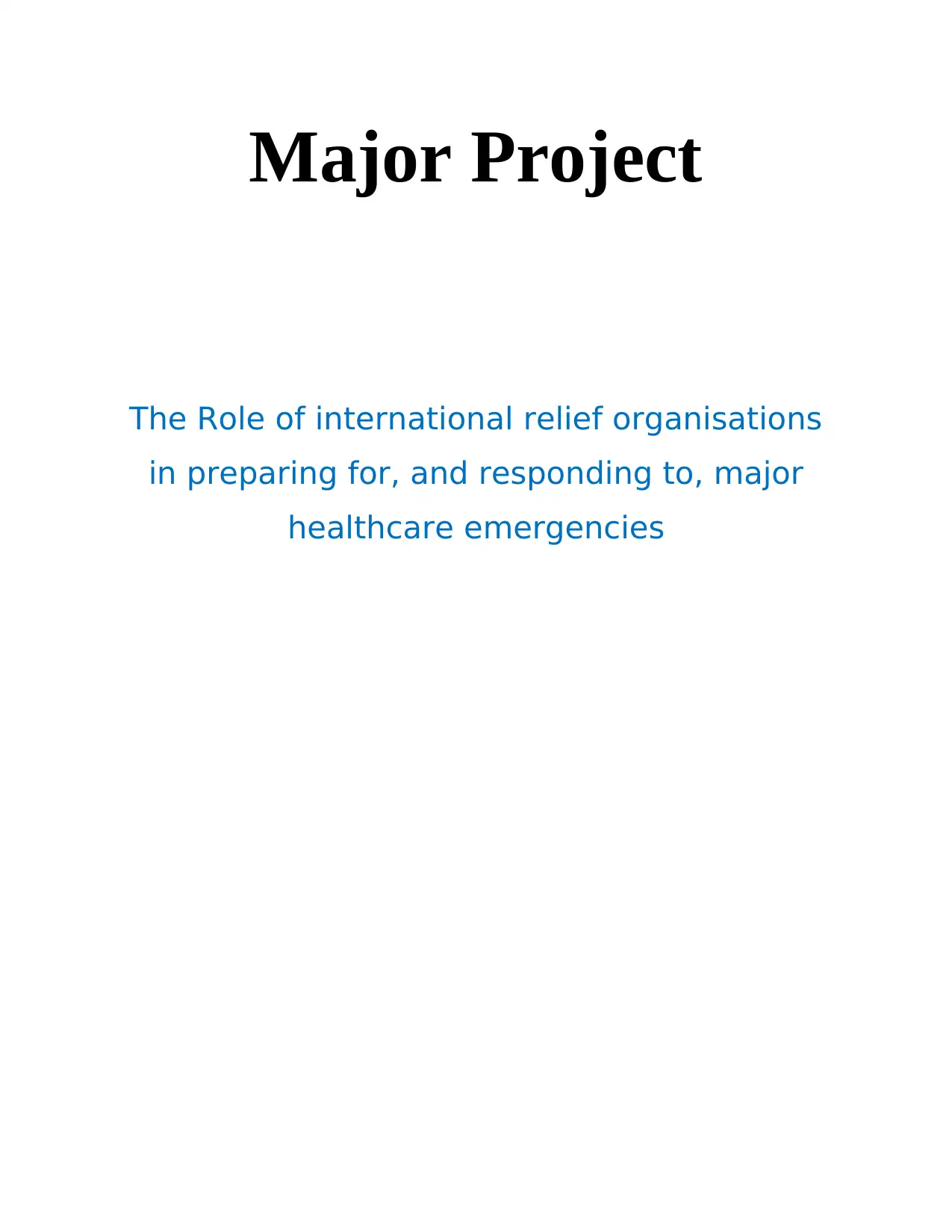
Major Project
The Role of international relief organisations
in preparing for, and responding to, major
healthcare emergencies
The Role of international relief organisations
in preparing for, and responding to, major
healthcare emergencies
Paraphrase This Document
Need a fresh take? Get an instant paraphrase of this document with our AI Paraphraser
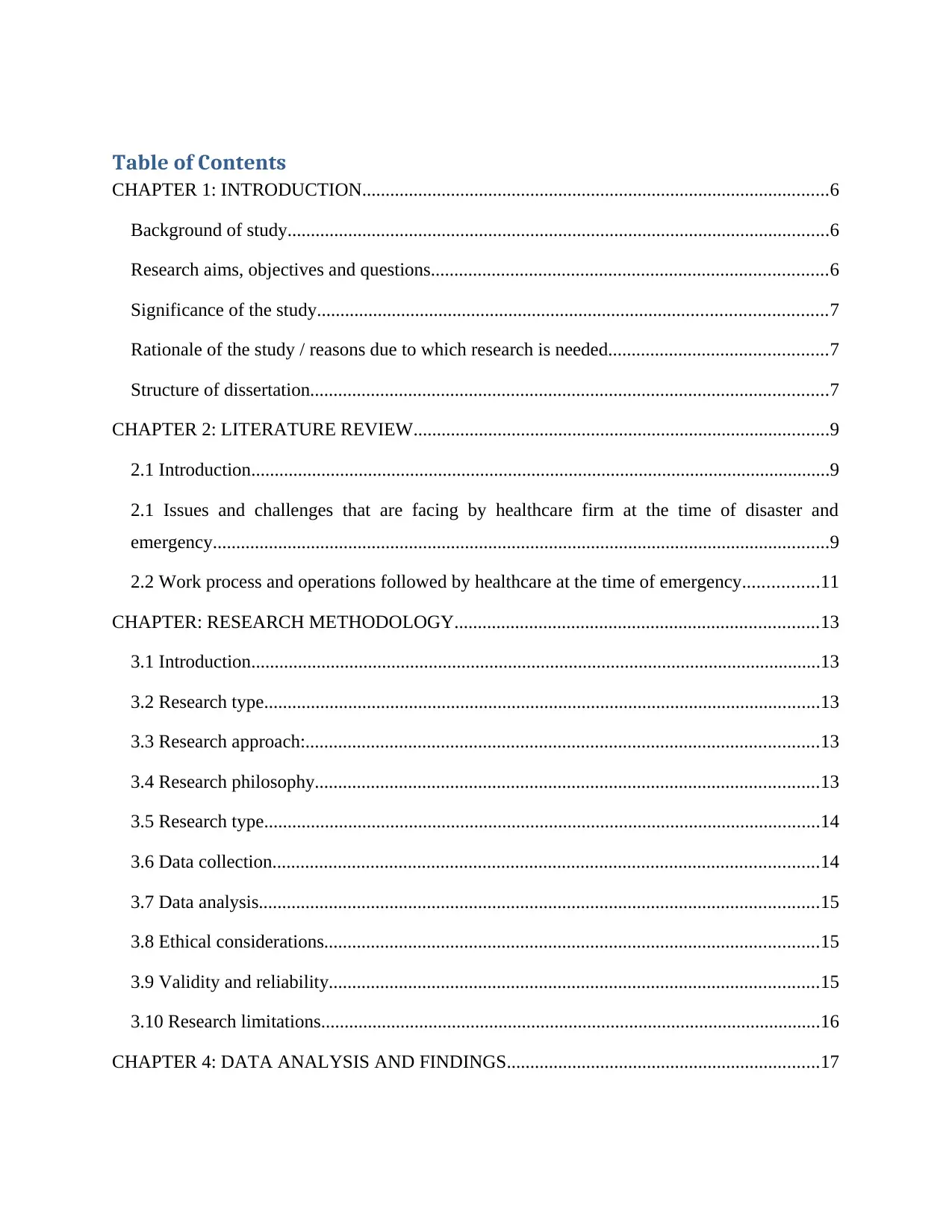
Table of Contents
CHAPTER 1: INTRODUCTION....................................................................................................6
Background of study....................................................................................................................6
Research aims, objectives and questions.....................................................................................6
Significance of the study.............................................................................................................7
Rationale of the study / reasons due to which research is needed...............................................7
Structure of dissertation...............................................................................................................7
CHAPTER 2: LITERATURE REVIEW.........................................................................................9
2.1 Introduction............................................................................................................................9
2.1 Issues and challenges that are facing by healthcare firm at the time of disaster and
emergency....................................................................................................................................9
2.2 Work process and operations followed by healthcare at the time of emergency................11
CHAPTER: RESEARCH METHODOLOGY..............................................................................13
3.1 Introduction..........................................................................................................................13
3.2 Research type.......................................................................................................................13
3.3 Research approach:..............................................................................................................13
3.4 Research philosophy............................................................................................................13
3.5 Research type.......................................................................................................................14
3.6 Data collection.....................................................................................................................14
3.7 Data analysis........................................................................................................................15
3.8 Ethical considerations..........................................................................................................15
3.9 Validity and reliability.........................................................................................................15
3.10 Research limitations...........................................................................................................16
CHAPTER 4: DATA ANALYSIS AND FINDINGS...................................................................17
CHAPTER 1: INTRODUCTION....................................................................................................6
Background of study....................................................................................................................6
Research aims, objectives and questions.....................................................................................6
Significance of the study.............................................................................................................7
Rationale of the study / reasons due to which research is needed...............................................7
Structure of dissertation...............................................................................................................7
CHAPTER 2: LITERATURE REVIEW.........................................................................................9
2.1 Introduction............................................................................................................................9
2.1 Issues and challenges that are facing by healthcare firm at the time of disaster and
emergency....................................................................................................................................9
2.2 Work process and operations followed by healthcare at the time of emergency................11
CHAPTER: RESEARCH METHODOLOGY..............................................................................13
3.1 Introduction..........................................................................................................................13
3.2 Research type.......................................................................................................................13
3.3 Research approach:..............................................................................................................13
3.4 Research philosophy............................................................................................................13
3.5 Research type.......................................................................................................................14
3.6 Data collection.....................................................................................................................14
3.7 Data analysis........................................................................................................................15
3.8 Ethical considerations..........................................................................................................15
3.9 Validity and reliability.........................................................................................................15
3.10 Research limitations...........................................................................................................16
CHAPTER 4: DATA ANALYSIS AND FINDINGS...................................................................17
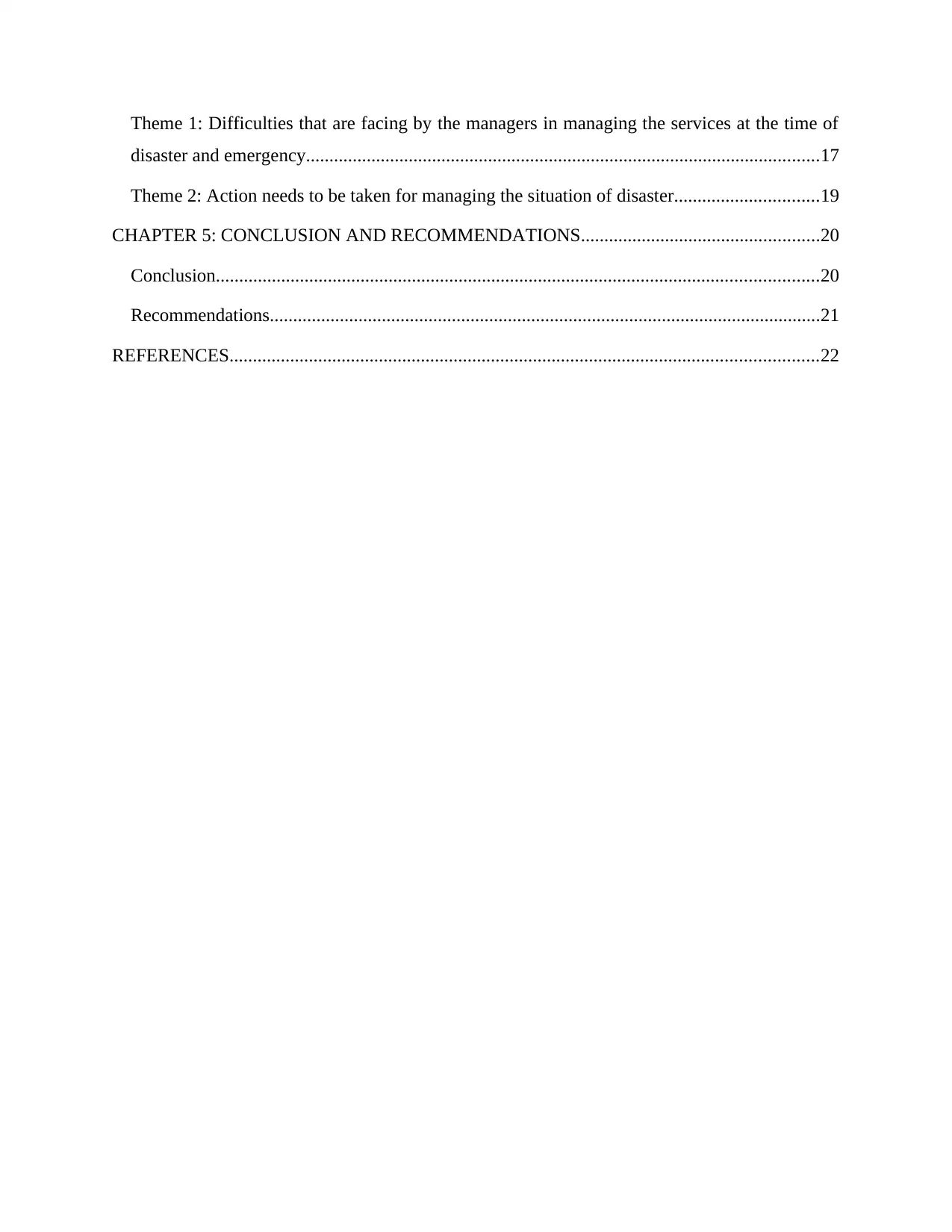
Theme 1: Difficulties that are facing by the managers in managing the services at the time of
disaster and emergency..............................................................................................................17
Theme 2: Action needs to be taken for managing the situation of disaster...............................19
CHAPTER 5: CONCLUSION AND RECOMMENDATIONS...................................................20
Conclusion.................................................................................................................................20
Recommendations......................................................................................................................21
REFERENCES..............................................................................................................................22
disaster and emergency..............................................................................................................17
Theme 2: Action needs to be taken for managing the situation of disaster...............................19
CHAPTER 5: CONCLUSION AND RECOMMENDATIONS...................................................20
Conclusion.................................................................................................................................20
Recommendations......................................................................................................................21
REFERENCES..............................................................................................................................22
⊘ This is a preview!⊘
Do you want full access?
Subscribe today to unlock all pages.

Trusted by 1+ million students worldwide
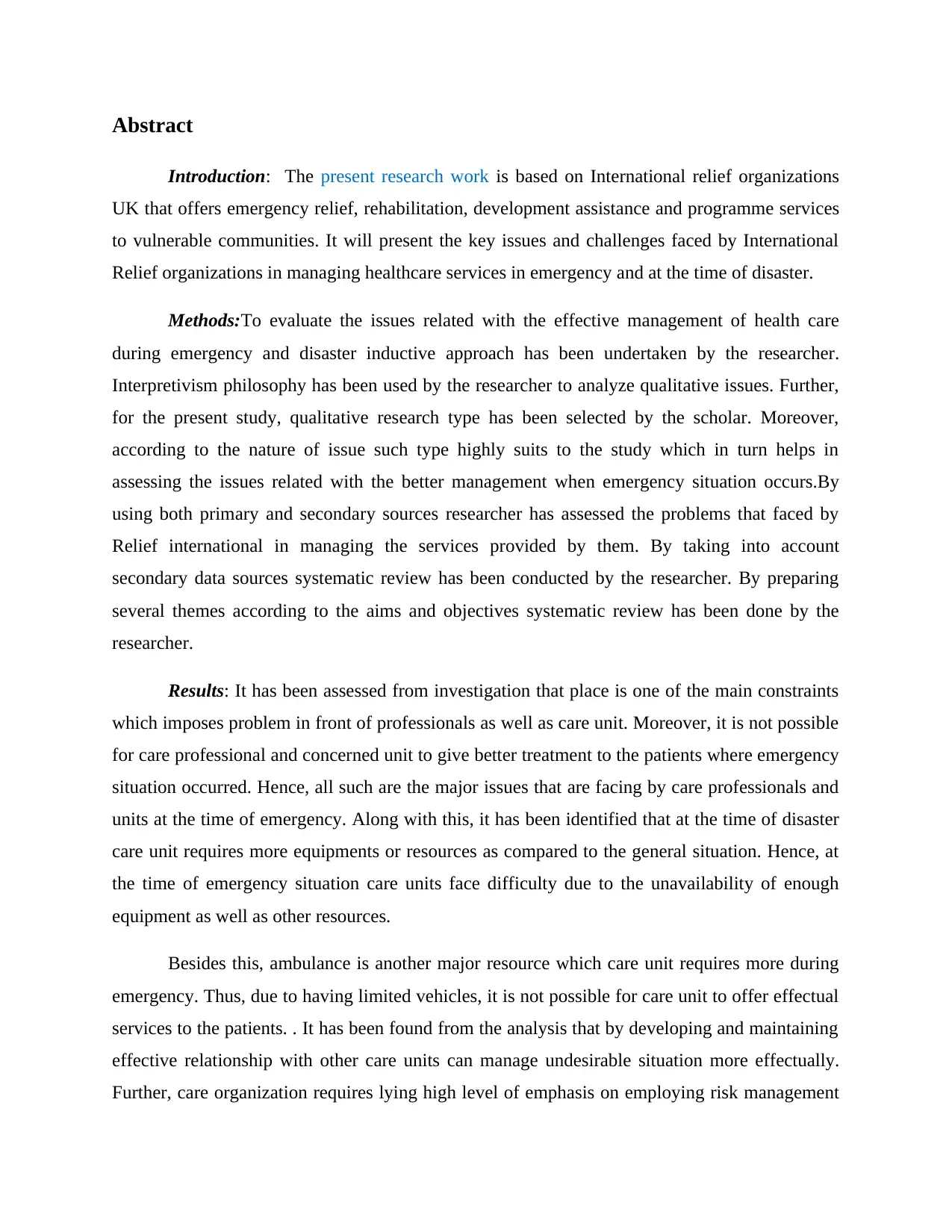
Abstract
Introduction: The present research work is based on International relief organizations
UK that offers emergency relief, rehabilitation, development assistance and programme services
to vulnerable communities. It will present the key issues and challenges faced by International
Relief organizations in managing healthcare services in emergency and at the time of disaster.
Methods:To evaluate the issues related with the effective management of health care
during emergency and disaster inductive approach has been undertaken by the researcher.
Interpretivism philosophy has been used by the researcher to analyze qualitative issues. Further,
for the present study, qualitative research type has been selected by the scholar. Moreover,
according to the nature of issue such type highly suits to the study which in turn helps in
assessing the issues related with the better management when emergency situation occurs.By
using both primary and secondary sources researcher has assessed the problems that faced by
Relief international in managing the services provided by them. By taking into account
secondary data sources systematic review has been conducted by the researcher. By preparing
several themes according to the aims and objectives systematic review has been done by the
researcher.
Results: It has been assessed from investigation that place is one of the main constraints
which imposes problem in front of professionals as well as care unit. Moreover, it is not possible
for care professional and concerned unit to give better treatment to the patients where emergency
situation occurred. Hence, all such are the major issues that are facing by care professionals and
units at the time of emergency. Along with this, it has been identified that at the time of disaster
care unit requires more equipments or resources as compared to the general situation. Hence, at
the time of emergency situation care units face difficulty due to the unavailability of enough
equipment as well as other resources.
Besides this, ambulance is another major resource which care unit requires more during
emergency. Thus, due to having limited vehicles, it is not possible for care unit to offer effectual
services to the patients. . It has been found from the analysis that by developing and maintaining
effective relationship with other care units can manage undesirable situation more effectually.
Further, care organization requires lying high level of emphasis on employing risk management
Introduction: The present research work is based on International relief organizations
UK that offers emergency relief, rehabilitation, development assistance and programme services
to vulnerable communities. It will present the key issues and challenges faced by International
Relief organizations in managing healthcare services in emergency and at the time of disaster.
Methods:To evaluate the issues related with the effective management of health care
during emergency and disaster inductive approach has been undertaken by the researcher.
Interpretivism philosophy has been used by the researcher to analyze qualitative issues. Further,
for the present study, qualitative research type has been selected by the scholar. Moreover,
according to the nature of issue such type highly suits to the study which in turn helps in
assessing the issues related with the better management when emergency situation occurs.By
using both primary and secondary sources researcher has assessed the problems that faced by
Relief international in managing the services provided by them. By taking into account
secondary data sources systematic review has been conducted by the researcher. By preparing
several themes according to the aims and objectives systematic review has been done by the
researcher.
Results: It has been assessed from investigation that place is one of the main constraints
which imposes problem in front of professionals as well as care unit. Moreover, it is not possible
for care professional and concerned unit to give better treatment to the patients where emergency
situation occurred. Hence, all such are the major issues that are facing by care professionals and
units at the time of emergency. Along with this, it has been identified that at the time of disaster
care unit requires more equipments or resources as compared to the general situation. Hence, at
the time of emergency situation care units face difficulty due to the unavailability of enough
equipment as well as other resources.
Besides this, ambulance is another major resource which care unit requires more during
emergency. Thus, due to having limited vehicles, it is not possible for care unit to offer effectual
services to the patients. . It has been found from the analysis that by developing and maintaining
effective relationship with other care units can manage undesirable situation more effectually.
Further, care organization requires lying high level of emphasis on employing risk management
Paraphrase This Document
Need a fresh take? Get an instant paraphrase of this document with our AI Paraphraser
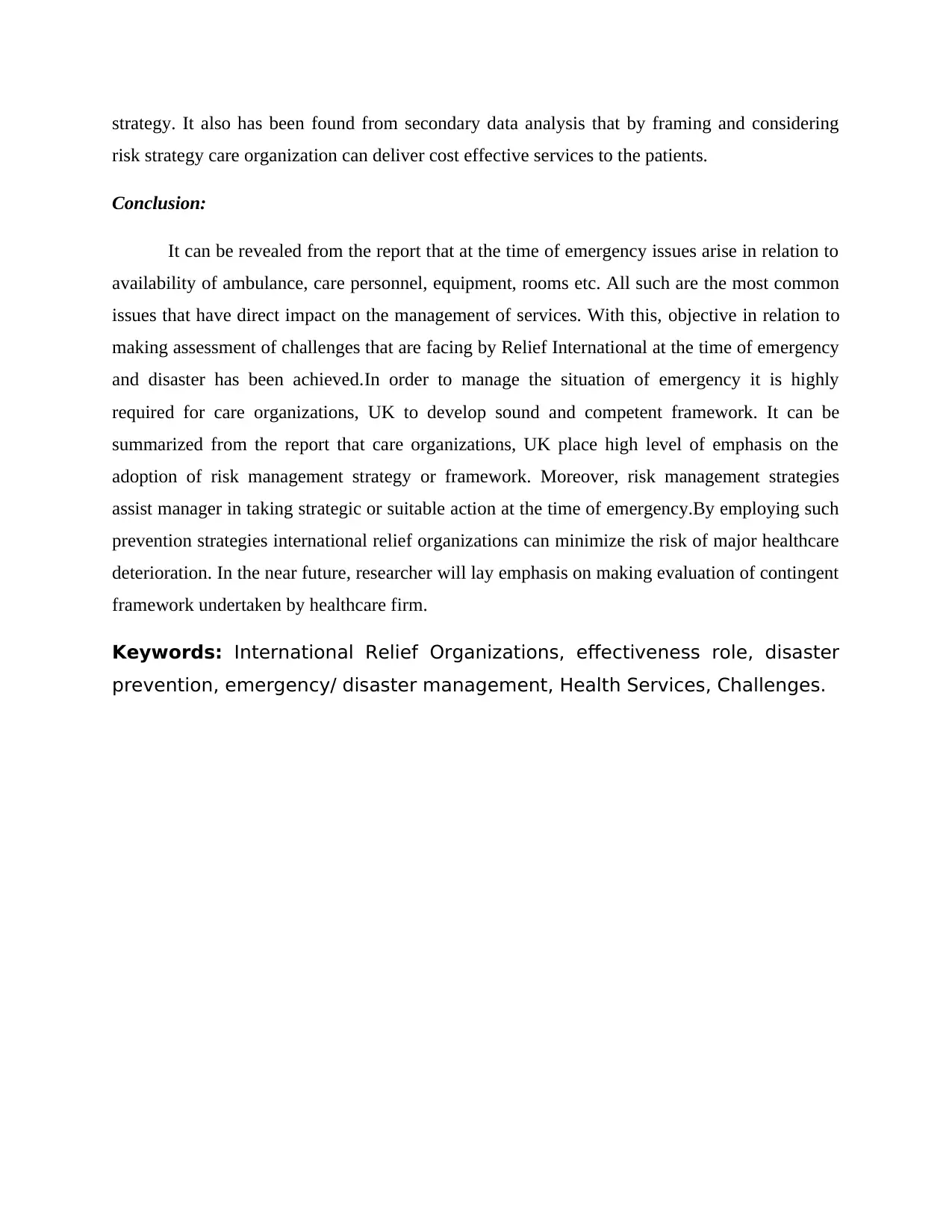
strategy. It also has been found from secondary data analysis that by framing and considering
risk strategy care organization can deliver cost effective services to the patients.
Conclusion:
It can be revealed from the report that at the time of emergency issues arise in relation to
availability of ambulance, care personnel, equipment, rooms etc. All such are the most common
issues that have direct impact on the management of services. With this, objective in relation to
making assessment of challenges that are facing by Relief International at the time of emergency
and disaster has been achieved.In order to manage the situation of emergency it is highly
required for care organizations, UK to develop sound and competent framework. It can be
summarized from the report that care organizations, UK place high level of emphasis on the
adoption of risk management strategy or framework. Moreover, risk management strategies
assist manager in taking strategic or suitable action at the time of emergency.By employing such
prevention strategies international relief organizations can minimize the risk of major healthcare
deterioration. In the near future, researcher will lay emphasis on making evaluation of contingent
framework undertaken by healthcare firm.
Keywords: International Relief Organizations, effectiveness role, disaster
prevention, emergency/ disaster management, Health Services, Challenges.
risk strategy care organization can deliver cost effective services to the patients.
Conclusion:
It can be revealed from the report that at the time of emergency issues arise in relation to
availability of ambulance, care personnel, equipment, rooms etc. All such are the most common
issues that have direct impact on the management of services. With this, objective in relation to
making assessment of challenges that are facing by Relief International at the time of emergency
and disaster has been achieved.In order to manage the situation of emergency it is highly
required for care organizations, UK to develop sound and competent framework. It can be
summarized from the report that care organizations, UK place high level of emphasis on the
adoption of risk management strategy or framework. Moreover, risk management strategies
assist manager in taking strategic or suitable action at the time of emergency.By employing such
prevention strategies international relief organizations can minimize the risk of major healthcare
deterioration. In the near future, researcher will lay emphasis on making evaluation of contingent
framework undertaken by healthcare firm.
Keywords: International Relief Organizations, effectiveness role, disaster
prevention, emergency/ disaster management, Health Services, Challenges.
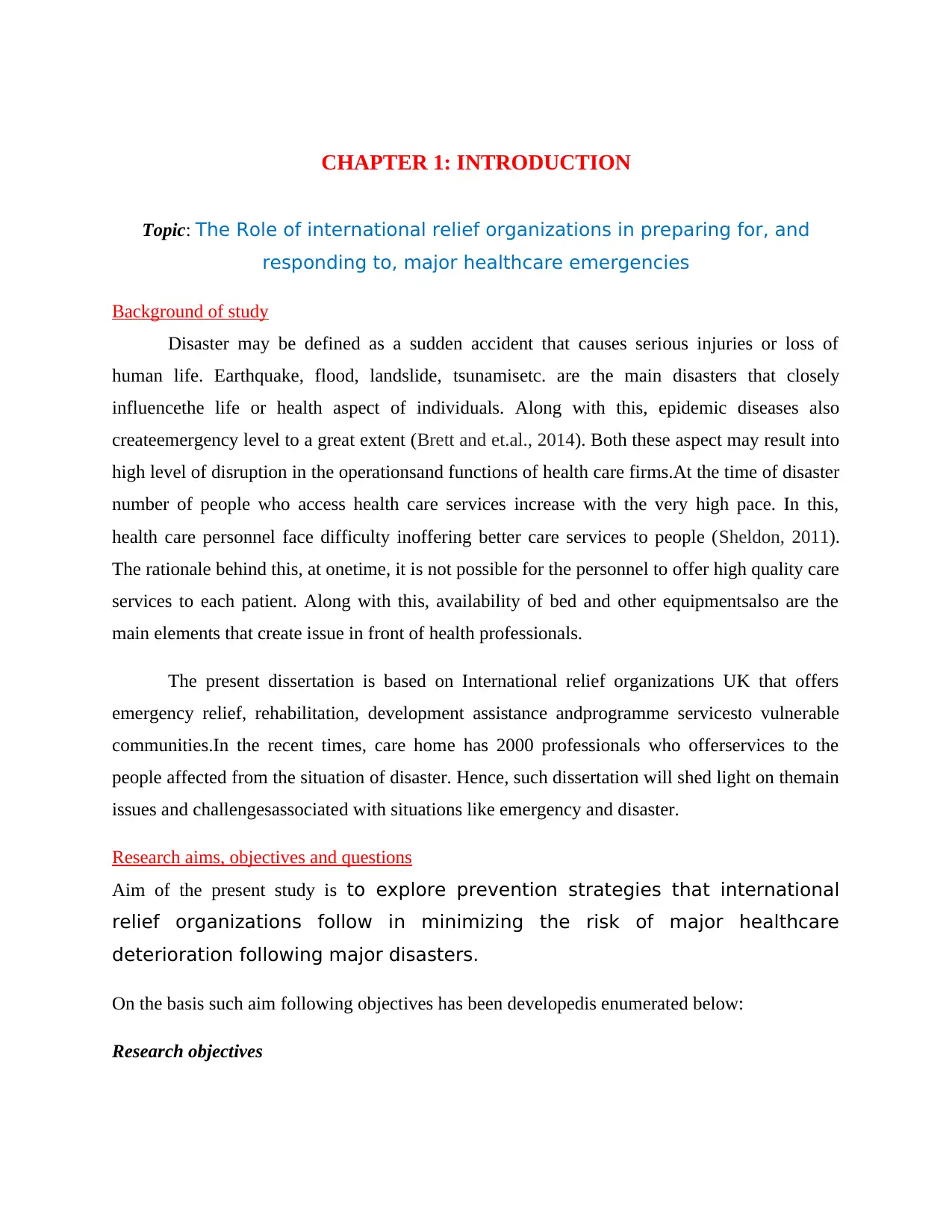
CHAPTER 1: INTRODUCTION
Topic: The Role of international relief organizations in preparing for, and
responding to, major healthcare emergencies
Background of study
Disaster may be defined as a sudden accident that causes serious injuries or loss of
human life. Earthquake, flood, landslide, tsunamisetc. are the main disasters that closely
influencethe life or health aspect of individuals. Along with this, epidemic diseases also
createemergency level to a great extent (Brett and et.al., 2014). Both these aspect may result into
high level of disruption in the operationsand functions of health care firms.At the time of disaster
number of people who access health care services increase with the very high pace. In this,
health care personnel face difficulty inoffering better care services to people (Sheldon, 2011).
The rationale behind this, at onetime, it is not possible for the personnel to offer high quality care
services to each patient. Along with this, availability of bed and other equipmentsalso are the
main elements that create issue in front of health professionals.
The present dissertation is based on International relief organizations UK that offers
emergency relief, rehabilitation, development assistance andprogramme servicesto vulnerable
communities.In the recent times, care home has 2000 professionals who offerservices to the
people affected from the situation of disaster. Hence, such dissertation will shed light on themain
issues and challengesassociated with situations like emergency and disaster.
Research aims, objectives and questions
Aim of the present study is to explore prevention strategies that international
relief organizations follow in minimizing the risk of major healthcare
deterioration following major disasters.
On the basis such aim following objectives has been developedis enumerated below:
Research objectives
Topic: The Role of international relief organizations in preparing for, and
responding to, major healthcare emergencies
Background of study
Disaster may be defined as a sudden accident that causes serious injuries or loss of
human life. Earthquake, flood, landslide, tsunamisetc. are the main disasters that closely
influencethe life or health aspect of individuals. Along with this, epidemic diseases also
createemergency level to a great extent (Brett and et.al., 2014). Both these aspect may result into
high level of disruption in the operationsand functions of health care firms.At the time of disaster
number of people who access health care services increase with the very high pace. In this,
health care personnel face difficulty inoffering better care services to people (Sheldon, 2011).
The rationale behind this, at onetime, it is not possible for the personnel to offer high quality care
services to each patient. Along with this, availability of bed and other equipmentsalso are the
main elements that create issue in front of health professionals.
The present dissertation is based on International relief organizations UK that offers
emergency relief, rehabilitation, development assistance andprogramme servicesto vulnerable
communities.In the recent times, care home has 2000 professionals who offerservices to the
people affected from the situation of disaster. Hence, such dissertation will shed light on themain
issues and challengesassociated with situations like emergency and disaster.
Research aims, objectives and questions
Aim of the present study is to explore prevention strategies that international
relief organizations follow in minimizing the risk of major healthcare
deterioration following major disasters.
On the basis such aim following objectives has been developedis enumerated below:
Research objectives
⊘ This is a preview!⊘
Do you want full access?
Subscribe today to unlock all pages.

Trusted by 1+ million students worldwide
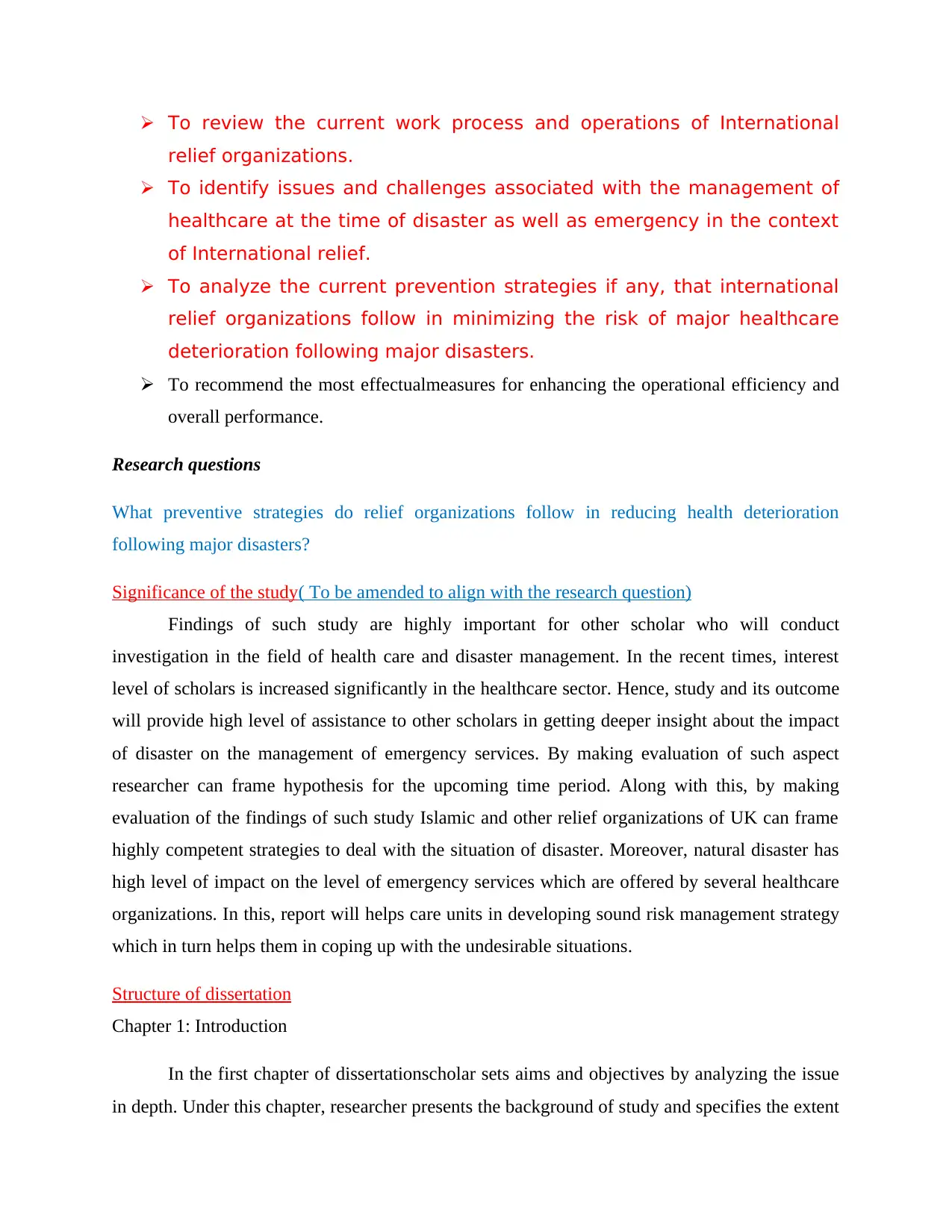
To review the current work process and operations of International
relief organizations.
To identify issues and challenges associated with the management of
healthcare at the time of disaster as well as emergency in the context
of International relief.
To analyze the current prevention strategies if any, that international
relief organizations follow in minimizing the risk of major healthcare
deterioration following major disasters.
To recommend the most effectualmeasures for enhancing the operational efficiency and
overall performance.
Research questions
What preventive strategies do relief organizations follow in reducing health deterioration
following major disasters?
Significance of the study( To be amended to align with the research question)
Findings of such study are highly important for other scholar who will conduct
investigation in the field of health care and disaster management. In the recent times, interest
level of scholars is increased significantly in the healthcare sector. Hence, study and its outcome
will provide high level of assistance to other scholars in getting deeper insight about the impact
of disaster on the management of emergency services. By making evaluation of such aspect
researcher can frame hypothesis for the upcoming time period. Along with this, by making
evaluation of the findings of such study Islamic and other relief organizations of UK can frame
highly competent strategies to deal with the situation of disaster. Moreover, natural disaster has
high level of impact on the level of emergency services which are offered by several healthcare
organizations. In this, report will helps care units in developing sound risk management strategy
which in turn helps them in coping up with the undesirable situations.
Structure of dissertation
Chapter 1: Introduction
In the first chapter of dissertationscholar sets aims and objectives by analyzing the issue
in depth. Under this chapter, researcher presents the background of study and specifies the extent
relief organizations.
To identify issues and challenges associated with the management of
healthcare at the time of disaster as well as emergency in the context
of International relief.
To analyze the current prevention strategies if any, that international
relief organizations follow in minimizing the risk of major healthcare
deterioration following major disasters.
To recommend the most effectualmeasures for enhancing the operational efficiency and
overall performance.
Research questions
What preventive strategies do relief organizations follow in reducing health deterioration
following major disasters?
Significance of the study( To be amended to align with the research question)
Findings of such study are highly important for other scholar who will conduct
investigation in the field of health care and disaster management. In the recent times, interest
level of scholars is increased significantly in the healthcare sector. Hence, study and its outcome
will provide high level of assistance to other scholars in getting deeper insight about the impact
of disaster on the management of emergency services. By making evaluation of such aspect
researcher can frame hypothesis for the upcoming time period. Along with this, by making
evaluation of the findings of such study Islamic and other relief organizations of UK can frame
highly competent strategies to deal with the situation of disaster. Moreover, natural disaster has
high level of impact on the level of emergency services which are offered by several healthcare
organizations. In this, report will helps care units in developing sound risk management strategy
which in turn helps them in coping up with the undesirable situations.
Structure of dissertation
Chapter 1: Introduction
In the first chapter of dissertationscholar sets aims and objectives by analyzing the issue
in depth. Under this chapter, researcher presents the background of study and specifies the extent
Paraphrase This Document
Need a fresh take? Get an instant paraphrase of this document with our AI Paraphraser
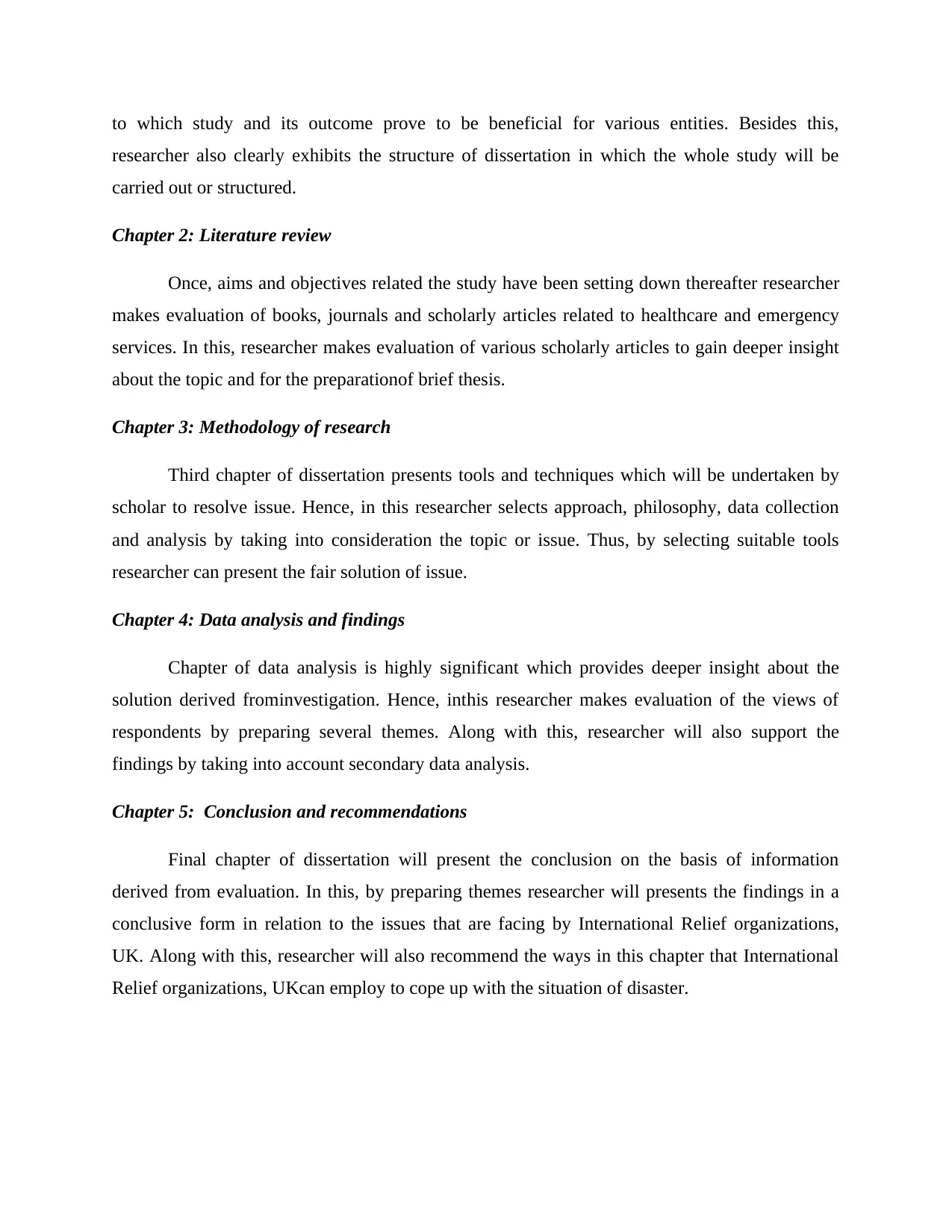
to which study and its outcome prove to be beneficial for various entities. Besides this,
researcher also clearly exhibits the structure of dissertation in which the whole study will be
carried out or structured.
Chapter 2: Literature review
Once, aims and objectives related the study have been setting down thereafter researcher
makes evaluation of books, journals and scholarly articles related to healthcare and emergency
services. In this, researcher makes evaluation of various scholarly articles to gain deeper insight
about the topic and for the preparationof brief thesis.
Chapter 3: Methodology of research
Third chapter of dissertation presents tools and techniques which will be undertaken by
scholar to resolve issue. Hence, in this researcher selects approach, philosophy, data collection
and analysis by taking into consideration the topic or issue. Thus, by selecting suitable tools
researcher can present the fair solution of issue.
Chapter 4: Data analysis and findings
Chapter of data analysis is highly significant which provides deeper insight about the
solution derived frominvestigation. Hence, inthis researcher makes evaluation of the views of
respondents by preparing several themes. Along with this, researcher will also support the
findings by taking into account secondary data analysis.
Chapter 5: Conclusion and recommendations
Final chapter of dissertation will present the conclusion on the basis of information
derived from evaluation. In this, by preparing themes researcher will presents the findings in a
conclusive form in relation to the issues that are facing by International Relief organizations,
UK. Along with this, researcher will also recommend the ways in this chapter that International
Relief organizations, UKcan employ to cope up with the situation of disaster.
researcher also clearly exhibits the structure of dissertation in which the whole study will be
carried out or structured.
Chapter 2: Literature review
Once, aims and objectives related the study have been setting down thereafter researcher
makes evaluation of books, journals and scholarly articles related to healthcare and emergency
services. In this, researcher makes evaluation of various scholarly articles to gain deeper insight
about the topic and for the preparationof brief thesis.
Chapter 3: Methodology of research
Third chapter of dissertation presents tools and techniques which will be undertaken by
scholar to resolve issue. Hence, in this researcher selects approach, philosophy, data collection
and analysis by taking into consideration the topic or issue. Thus, by selecting suitable tools
researcher can present the fair solution of issue.
Chapter 4: Data analysis and findings
Chapter of data analysis is highly significant which provides deeper insight about the
solution derived frominvestigation. Hence, inthis researcher makes evaluation of the views of
respondents by preparing several themes. Along with this, researcher will also support the
findings by taking into account secondary data analysis.
Chapter 5: Conclusion and recommendations
Final chapter of dissertation will present the conclusion on the basis of information
derived from evaluation. In this, by preparing themes researcher will presents the findings in a
conclusive form in relation to the issues that are facing by International Relief organizations,
UK. Along with this, researcher will also recommend the ways in this chapter that International
Relief organizations, UKcan employ to cope up with the situation of disaster.
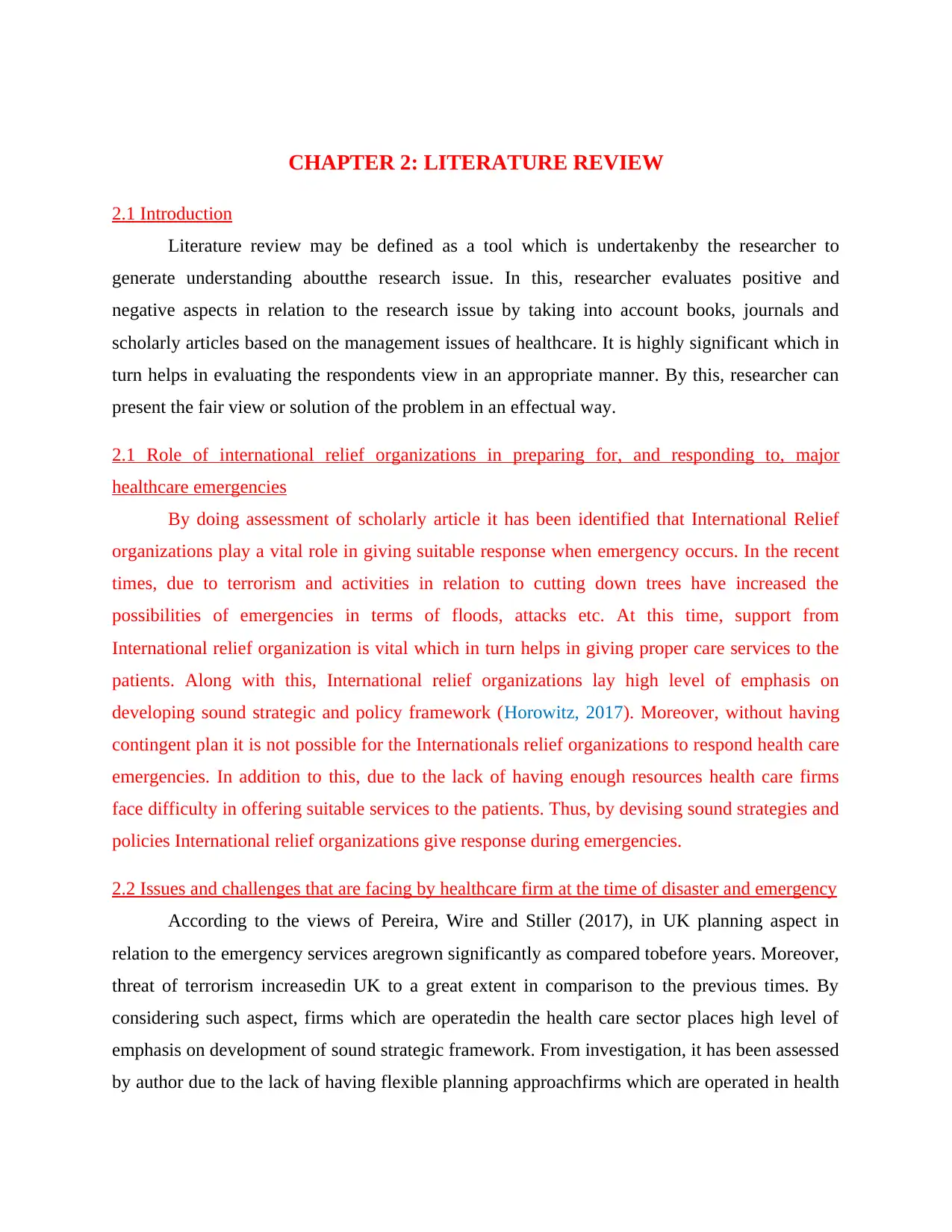
CHAPTER 2: LITERATURE REVIEW
2.1 Introduction
Literature review may be defined as a tool which is undertakenby the researcher to
generate understanding aboutthe research issue. In this, researcher evaluates positive and
negative aspects in relation to the research issue by taking into account books, journals and
scholarly articles based on the management issues of healthcare. It is highly significant which in
turn helps in evaluating the respondents view in an appropriate manner. By this, researcher can
present the fair view or solution of the problem in an effectual way.
2.1 Role of international relief organizations in preparing for, and responding to, major
healthcare emergencies
By doing assessment of scholarly article it has been identified that International Relief
organizations play a vital role in giving suitable response when emergency occurs. In the recent
times, due to terrorism and activities in relation to cutting down trees have increased the
possibilities of emergencies in terms of floods, attacks etc. At this time, support from
International relief organization is vital which in turn helps in giving proper care services to the
patients. Along with this, International relief organizations lay high level of emphasis on
developing sound strategic and policy framework (Horowitz, 2017). Moreover, without having
contingent plan it is not possible for the Internationals relief organizations to respond health care
emergencies. In addition to this, due to the lack of having enough resources health care firms
face difficulty in offering suitable services to the patients. Thus, by devising sound strategies and
policies International relief organizations give response during emergencies.
2.2 Issues and challenges that are facing by healthcare firm at the time of disaster and emergency
According to the views of Pereira, Wire and Stiller (2017), in UK planning aspect in
relation to the emergency services aregrown significantly as compared tobefore years. Moreover,
threat of terrorism increasedin UK to a great extent in comparison to the previous times. By
considering such aspect, firms which are operatedin the health care sector places high level of
emphasis on development of sound strategic framework. From investigation, it has been assessed
by author due to the lack of having flexible planning approachfirms which are operated in health
2.1 Introduction
Literature review may be defined as a tool which is undertakenby the researcher to
generate understanding aboutthe research issue. In this, researcher evaluates positive and
negative aspects in relation to the research issue by taking into account books, journals and
scholarly articles based on the management issues of healthcare. It is highly significant which in
turn helps in evaluating the respondents view in an appropriate manner. By this, researcher can
present the fair view or solution of the problem in an effectual way.
2.1 Role of international relief organizations in preparing for, and responding to, major
healthcare emergencies
By doing assessment of scholarly article it has been identified that International Relief
organizations play a vital role in giving suitable response when emergency occurs. In the recent
times, due to terrorism and activities in relation to cutting down trees have increased the
possibilities of emergencies in terms of floods, attacks etc. At this time, support from
International relief organization is vital which in turn helps in giving proper care services to the
patients. Along with this, International relief organizations lay high level of emphasis on
developing sound strategic and policy framework (Horowitz, 2017). Moreover, without having
contingent plan it is not possible for the Internationals relief organizations to respond health care
emergencies. In addition to this, due to the lack of having enough resources health care firms
face difficulty in offering suitable services to the patients. Thus, by devising sound strategies and
policies International relief organizations give response during emergencies.
2.2 Issues and challenges that are facing by healthcare firm at the time of disaster and emergency
According to the views of Pereira, Wire and Stiller (2017), in UK planning aspect in
relation to the emergency services aregrown significantly as compared tobefore years. Moreover,
threat of terrorism increasedin UK to a great extent in comparison to the previous times. By
considering such aspect, firms which are operatedin the health care sector places high level of
emphasis on development of sound strategic framework. From investigation, it has been assessed
by author due to the lack of having flexible planning approachfirms which are operated in health
⊘ This is a preview!⊘
Do you want full access?
Subscribe today to unlock all pages.

Trusted by 1+ million students worldwide

care sector face problem in relation toemergency management (Levy, Koch and Royne,
2017).Moreover, in the case of strict planning approach it is not possible for the firm to make
changes in the existing framework. However, on the critical note, Campbell, Neill and Higgins
(2017) presented that there is a disconnection between the entities thatdrafts and implement the
plan. Moreover, without having deeper insight about the manner in which plan needs to
implement personnel are not able to carry out activities effectually at the time of emergency.
Hence, effectual and clear communication is highly required between the members for managing
all the aspects in a prominent way(Reilly and Markenson, 2017).Due to the lack of having
effectual communication system business units face difficultyin managing the emergency
services or aspects.
In accordance with Leonard, Hughes and Pruitt (2017) at the time of natural disaster and
emergency care unit requires more bed, medicines and other aspects which are highly associated
with providing services to the patients. Moreover, care unit maintains standard bed by
considering the average level of requirements and availability of space. However, at the time of
emergency, manager of care organization faces difficulty in delivering high quality services to
the patients. In addition to this, waiting line also increased significantly at the time of emergency
due to having limited equipmentsor machineries for check up. Meacock and et.al., (2017)
claimed that care organization faces difficulty in managing the operation not only due to the
people who suffered from disastrous aspect but also from local people. Moreover, at the time of
emergency, local people also faces several healthrelated issues and require specific care
services(Horowitz, 2017).Hence, it is one of the main aspects due to which waiting line increases
to a great extent. Due to such aspect, careunit faces difficulty in coping up with the situation of
emergency.
Phillips and et.al., (2017) foundin their investigation that place at which emergency
created also impose problem in front of care organizations operated inUK. Moreover, care unit
is in position to offer only primary aid facility to the patientson such concerned place. It is not
possible for the health care organization to develop effectual setup and offer highly effectual care
services to the patients. In the recent times, government authority places orderto offer medical
services to people who either suffered from natural disaster situation such as earthquake storm
etc. or terrorists attack(Levy, Koch and Royne, 2017).In this, place at which undesirable
2017).Moreover, in the case of strict planning approach it is not possible for the firm to make
changes in the existing framework. However, on the critical note, Campbell, Neill and Higgins
(2017) presented that there is a disconnection between the entities thatdrafts and implement the
plan. Moreover, without having deeper insight about the manner in which plan needs to
implement personnel are not able to carry out activities effectually at the time of emergency.
Hence, effectual and clear communication is highly required between the members for managing
all the aspects in a prominent way(Reilly and Markenson, 2017).Due to the lack of having
effectual communication system business units face difficultyin managing the emergency
services or aspects.
In accordance with Leonard, Hughes and Pruitt (2017) at the time of natural disaster and
emergency care unit requires more bed, medicines and other aspects which are highly associated
with providing services to the patients. Moreover, care unit maintains standard bed by
considering the average level of requirements and availability of space. However, at the time of
emergency, manager of care organization faces difficulty in delivering high quality services to
the patients. In addition to this, waiting line also increased significantly at the time of emergency
due to having limited equipmentsor machineries for check up. Meacock and et.al., (2017)
claimed that care organization faces difficulty in managing the operation not only due to the
people who suffered from disastrous aspect but also from local people. Moreover, at the time of
emergency, local people also faces several healthrelated issues and require specific care
services(Horowitz, 2017).Hence, it is one of the main aspects due to which waiting line increases
to a great extent. Due to such aspect, careunit faces difficulty in coping up with the situation of
emergency.
Phillips and et.al., (2017) foundin their investigation that place at which emergency
created also impose problem in front of care organizations operated inUK. Moreover, care unit
is in position to offer only primary aid facility to the patientson such concerned place. It is not
possible for the health care organization to develop effectual setup and offer highly effectual care
services to the patients. In the recent times, government authority places orderto offer medical
services to people who either suffered from natural disaster situation such as earthquake storm
etc. or terrorists attack(Levy, Koch and Royne, 2017).In this, place at which undesirable
Paraphrase This Document
Need a fresh take? Get an instant paraphrase of this document with our AI Paraphraser

activities happened creates difficulty in managing theemergency situation. For
instance:Countries ofEuropean is always ready to help each other. Hence, if situation of natural
disaster occurred in Denmarkthen it is not possible for careorganizations of UK to deliver high
quality services at such place.
However, Darby and et.al., (2017) argued that care organizations can offer quality
services with the governmental support. Moreover, government authority provides care units
with all the possible resources which they require for offering services to the patients. Buttke and
et.al., (2017) stated that international relief organizations work in UK faces difficulty in the
management of emergency servicesbecause at this time care unit needs enough and skilled
personnel. At the time of emergency, to handle large number of patients care unit requires more
personnel as compared to daily need or level(Pescaroli and Kelman, 2017).Besides this,
competent personnel are another main requirement to handle the situation of emergencies.
Moreover, care personnel can handle the undesirable situation more effectually only when they
haveleadership, communication, analytical thinking and decision making ability (Speier,
Sherman and Speier, 2017). Moreover, if managers and senior authorities do not have ability to
give clear instructions to the subordinates then it may result into more issues. Along with this,
personnel of healthcare must have ability to take suitable decision in accordance with the
situation (Kligerman, Walmer and Bereknyei Merrell, 2017).In the absence of having all such
skills among the personnel care units face problem in managing or coping up with the emergency
situation.
In their own investigation, Bunn and et.al., (2017) presented that care organizations of
UK face issue in managing emergency due to the transportation issues. At the time of
emergency, care unit needs more ambulances for fulfilling the needsof patient.The rationale
behind this, at the time of natural disaster and terrorists attack people who requires medication
facility increases significantly.Hence, to save the life of individualscare unit requires more
ambulance (Gowing and et.al., 2017). Thus, due to the lack of having enough facility care unit
faces difficulty in offering service or facilities to the patients.
instance:Countries ofEuropean is always ready to help each other. Hence, if situation of natural
disaster occurred in Denmarkthen it is not possible for careorganizations of UK to deliver high
quality services at such place.
However, Darby and et.al., (2017) argued that care organizations can offer quality
services with the governmental support. Moreover, government authority provides care units
with all the possible resources which they require for offering services to the patients. Buttke and
et.al., (2017) stated that international relief organizations work in UK faces difficulty in the
management of emergency servicesbecause at this time care unit needs enough and skilled
personnel. At the time of emergency, to handle large number of patients care unit requires more
personnel as compared to daily need or level(Pescaroli and Kelman, 2017).Besides this,
competent personnel are another main requirement to handle the situation of emergencies.
Moreover, care personnel can handle the undesirable situation more effectually only when they
haveleadership, communication, analytical thinking and decision making ability (Speier,
Sherman and Speier, 2017). Moreover, if managers and senior authorities do not have ability to
give clear instructions to the subordinates then it may result into more issues. Along with this,
personnel of healthcare must have ability to take suitable decision in accordance with the
situation (Kligerman, Walmer and Bereknyei Merrell, 2017).In the absence of having all such
skills among the personnel care units face problem in managing or coping up with the emergency
situation.
In their own investigation, Bunn and et.al., (2017) presented that care organizations of
UK face issue in managing emergency due to the transportation issues. At the time of
emergency, care unit needs more ambulances for fulfilling the needsof patient.The rationale
behind this, at the time of natural disaster and terrorists attack people who requires medication
facility increases significantly.Hence, to save the life of individualscare unit requires more
ambulance (Gowing and et.al., 2017). Thus, due to the lack of having enough facility care unit
faces difficulty in offering service or facilities to the patients.

2.3 The current prevention strategies if any, that international relief organizations follow in
minimizing the risk of major healthcare deterioration following major disasters
In accordance with Remick and et.al., (2017) at the time of emergency care unit requires
to place high level emphasis on effective communication aspect. Moreover, communication is
the key which in turn helps in coordinating all the activities more effectually. Hence, at the time
of emergency by communicating each and every aspect with the team care unit can offer quality
services to the patients. However, on the critical note, D’Onofrio and et.al., (2017) said that
leadership is vital for managing the work process or aspects at the time of emergency. The
rationale behind this, during the condition of emergency individuals or care personnel
requiresguidanceabout how to manage work and overall situation. Moreover, at the time of
emergency need of care personnel increases to the significant level (Lin and et.al., 2017). Along
with this, effectual coordination is also required among the personnel to manage work process at
the time of disaster. Hence, by providing guidance to the personnel regarding working
aspectconcerned authoritycan improve the work process or aspects to the significant level.
On the other side, Robertson (2017)stated that by framing strategic and competent
planmanager of health care organization can make improvement in the work process or
operations top a great extent. Moreover, without having sound strategic framework care units
face difficulty in making their best efforts inthe right direction. Further, Bourgois and et.al.,
(2017) presented that by delegating the roles and responsibilities of personnel higher authority of
health careorganization canfacilitate smooth functioning of the business or work process and
aspects. Moreover, when roles and responsibilitiesof individuals are not delegated properly then
it may result into duplication of work. Thus, by assigning responsibilities to the individuals care
unit can ensure smooth functioning of the working process or aspects.
minimizing the risk of major healthcare deterioration following major disasters
In accordance with Remick and et.al., (2017) at the time of emergency care unit requires
to place high level emphasis on effective communication aspect. Moreover, communication is
the key which in turn helps in coordinating all the activities more effectually. Hence, at the time
of emergency by communicating each and every aspect with the team care unit can offer quality
services to the patients. However, on the critical note, D’Onofrio and et.al., (2017) said that
leadership is vital for managing the work process or aspects at the time of emergency. The
rationale behind this, during the condition of emergency individuals or care personnel
requiresguidanceabout how to manage work and overall situation. Moreover, at the time of
emergency need of care personnel increases to the significant level (Lin and et.al., 2017). Along
with this, effectual coordination is also required among the personnel to manage work process at
the time of disaster. Hence, by providing guidance to the personnel regarding working
aspectconcerned authoritycan improve the work process or aspects to the significant level.
On the other side, Robertson (2017)stated that by framing strategic and competent
planmanager of health care organization can make improvement in the work process or
operations top a great extent. Moreover, without having sound strategic framework care units
face difficulty in making their best efforts inthe right direction. Further, Bourgois and et.al.,
(2017) presented that by delegating the roles and responsibilities of personnel higher authority of
health careorganization canfacilitate smooth functioning of the business or work process and
aspects. Moreover, when roles and responsibilitiesof individuals are not delegated properly then
it may result into duplication of work. Thus, by assigning responsibilities to the individuals care
unit can ensure smooth functioning of the working process or aspects.
⊘ This is a preview!⊘
Do you want full access?
Subscribe today to unlock all pages.

Trusted by 1+ million students worldwide
1 out of 24
Related Documents
Your All-in-One AI-Powered Toolkit for Academic Success.
+13062052269
info@desklib.com
Available 24*7 on WhatsApp / Email
![[object Object]](/_next/static/media/star-bottom.7253800d.svg)
Unlock your academic potential
Copyright © 2020–2025 A2Z Services. All Rights Reserved. Developed and managed by ZUCOL.





